48 Hour Dubrovnik Itinerary

Day One
3 PM (and Three Flights Later) : Arriving in Dubrovnik
We flew into Dubrovnik and rented a car for the first leg of our trip. The road into the city hugs the Adriatic Sea, providing us with views that were enough to make us forget about the 3 planes we had taken to get there. After a beautiful 20-minute drive, we arrived at our Airbnb! We had a tough time deciding where to stay in Dubrovnik as there were lots of amazing options. While in Dubrovnik, we would learn that very few Croatians who own apartments in the Old Town actually live in them, since they can make so much renting them out to tourists (and because they don’t want to be in town in the summer when the area gets completely swarmed). Croatia has seen a huge boom in tourism since 2010, but is luckily still a relatively affordable destination!
We stayed at an Airbnb outside of the Old Town, primarily because we had a car with us (there are no cars in the Old Town), but also because of the apartment’s amazing balcony! We were about a 10 minute walk from the Old Town, but the trip was vertical — so definitely keep that in mind if you’re considering staying on the outskirts. We had extremely warm and welcoming hosts who even offered to park our car for us to get it into a small parking spot. We almost always use Airbnb when we travel now, and if you haven’t you need to try it (and you can get $40 off your first stay)!
After checking into the apartment and admiring its sweeping views of the city, we decided to venture into the Old Town to take advantage of the last few hours of the day.
5 PM : Grabbing a Drink at a Hole in the Wall Rock
We had arrived just in time for Happy Hour and headed to one of Dubrovnik’s coolest bars — Bar Buza. The bar has been built into the side of a rock overlooking the water on the Southern side of the city walls. The only sign for Bar Buza reads “Cold Drinks” — follow it and you’ll be transported from the winding city streets to a small bar perched above the blue water.
From Bar Buza, you can admire all the ships coming in and out of the harbor and catch your first glimpse of Lokrum Island. The drinks at Bar Buza are simple, an assortment of bottled beers and sodas. Keep in mind, Bar Buza is small; it only has 10-15 tables and has become a popular spot. But, you can also take your drink down past the tables and find a spot on one of the rocks — this is where we sat and watched the more adventurous people jumping into the water.
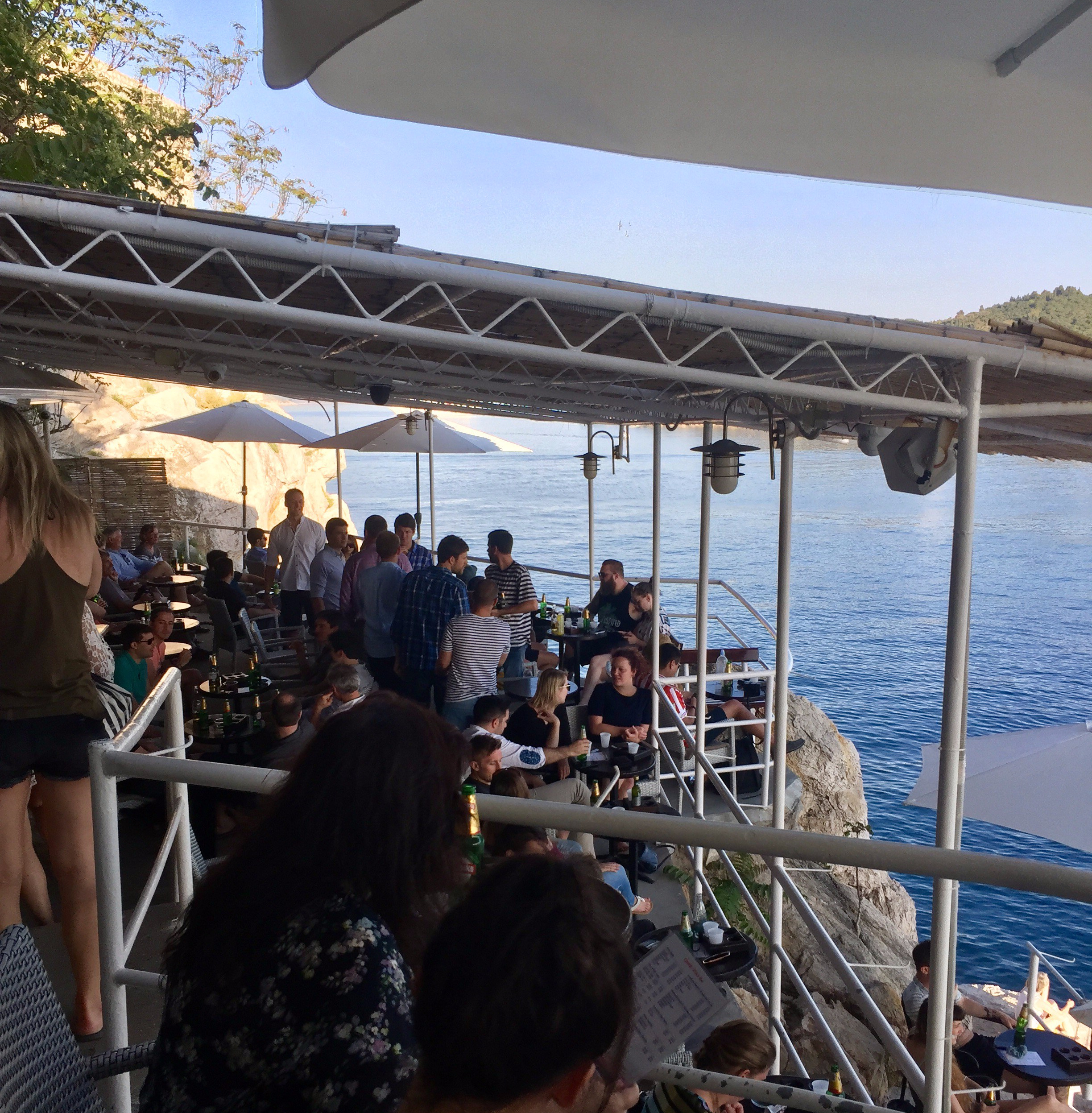
Tables at Bar Buza
Another happy hour favorite is Dodo Bar. Dodo seems like it could’ve been transplanted from the Caribbean — with swinging chairs and funny signs about the beach. It too has beautiful ocean views, but is situated in a cove and is only a few steps above sea level. Try Dodo if you’re craving a fancier cocktail or if you’re scared Bar Buza may be a bit too crowded for your jet-lagged self. It’s also much closer to Pile Gate — the main entrance into the Old Town.
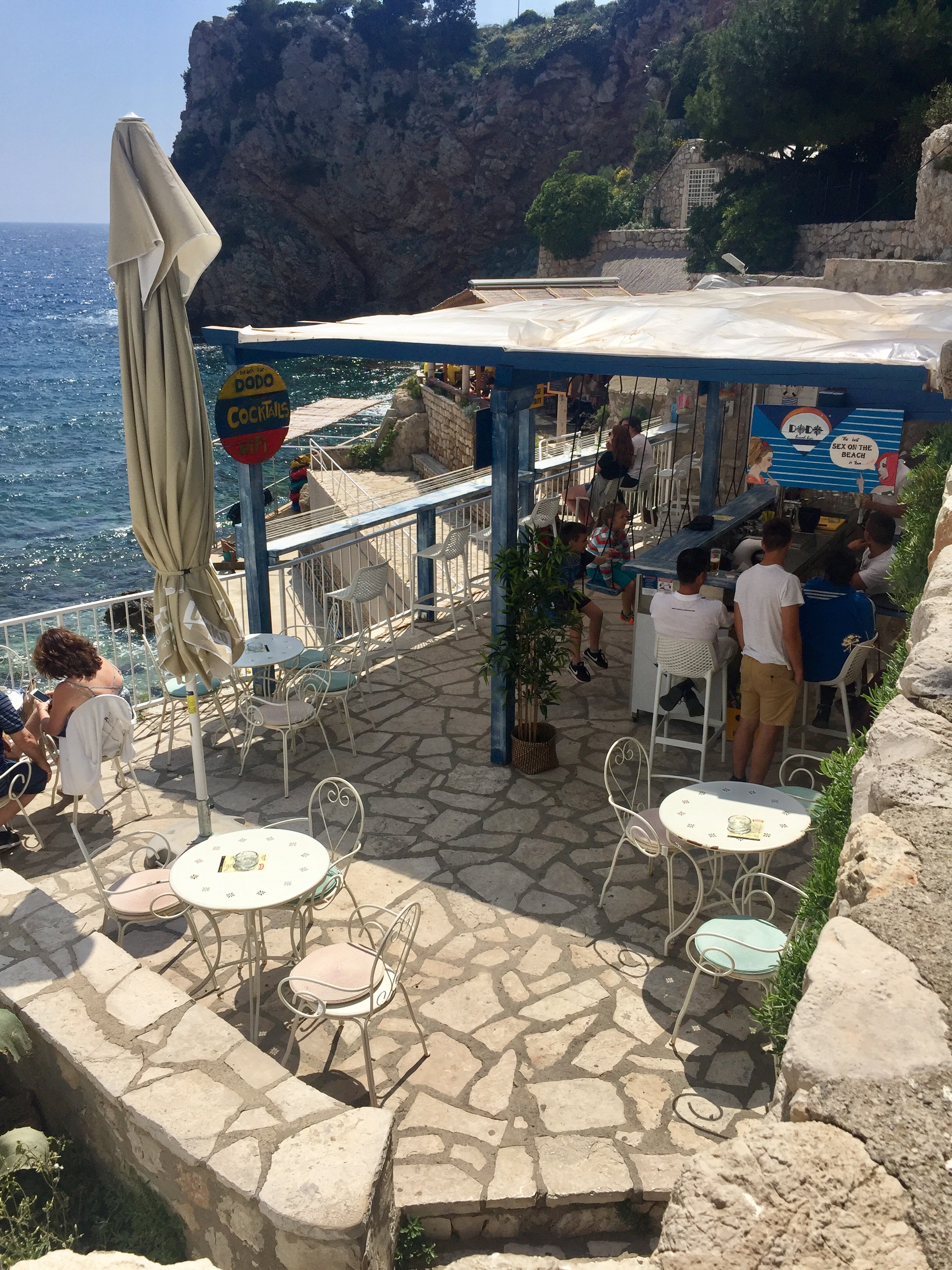
Dodo Bar
7 PM : A First Taste of Croatia
We ate our first meal in Dubrovnik at Restaurant Horizont. The restaurant has lovely tables outside lining its steps and we were able to sit at the first table overlooking the New Port — one of the perks of eating dinner earlier than anyone else in Dubrovnik! We had a delicious beef carpaccio with a parmesan and gorgonzola fondue and a shrimp risotto. It was a delicious first meal and made us excited to eat our way through the rest of the country. As we left, the remaining tables lining the steps had filled up — I’d definitely suggest making reservations for your trip as the popular restaurants were crowded, even in May!
- Beef Carpaccio
- Shrimp Risotto
Following dinner, we climbed back up to our apartment and fell asleep quickly to prepare for an early morning.
Day Two
10 AM : Crash Course on Dubrovnik’s History
We started our day with an hour walking tour of Dubrovnik with Dubrovnik Walking Tours. Dubrovnik is full of history — a city which was historically a vital shipping port was also under siege just a few decades ago. The political climate of the city has changed drastically in mine and your lifetimes, and it’s not often you have the opportunity to hear about such world-altering events from a first-hand perspective. The recent history of Croatia and its separation from Yugoslavia isn’t easy to understand. For those of you who are interested, I’ll summarize what I learned in Croatia as succinctly as possible, because the more you know going into it, the easier it will be to understand the grittier details!
» A Quick Note on the History of Croatia
Until 1991, Croatia was a part of Yugoslavia — a country made of 6 republics (Bosnia and Herzegovina, Croatia, Slovenia, Macedonia, Serbia, and Montenegro). In 1980, Tito, the unifying president of Yugoslavia, passed away. Over the coming years, the republics started to gain more autonomy — a system was established to rotate the presidency of the country between the republics. Without Tito’s leadership, ethnic tensions began to rise over the next decade, and when Serbia elected Slobodan Milosevic as president, he began to curtail that autonomy. Both Croatia and Slovenia were skeptical of Milosevic’s actions, and in 1990, Croatia held its first free election since 1938. The Croatian Democratic Union won the majority of parliament seats and moved to hold an independence referendum — in which 93% of people voted for independence from Yugoslavia. It’s important to note that all of the Yugoslav countries were melting pots and at the time, 12% of the population of Croatia were Croatian Serbs. Many of them joined the Serb-controlled Yugoslav’s People Army (JNA) and began to rebel against Croatian independence. Dalmatia, and Dubrovnik, were both vulnerable to attack due to their proximity to the border with Bosnia and Herzegovina.
The JNA advanced towards Dubrovnik on October 1st, 1991. The sentiment in Croatia, and seemingly around the world, was that Dubrovnik would not be invaded due to its UNESCO Heritage Site classification. At this point, the JNA controlled roughly 1/3 of Croatia — including all the territory surrounding Dubrovnik. It went on to attack Dubrovnik in a siege that lasted nine months, killed 417 people, and damaged ~55% of the buildings in the Old Town. The Siege, and seeing a popular resort town up in flames, also served to shift the international perception of Serbia and its actions. Despite having hastily arranged defense, Dubrovnik was never conquered and Croatian forces drove out the JNA in July 1992. Fort Imperial, looming above Dubrovnik on Srd Hill, played an important role in defending the city.
Another reason it’s helpful to read a bit of history on the breakup of Yugoslavia before making the trip there is because each country recounts and teaches the events differently. The name of the events can’t even be agreed upon — in Croatia it’s called the “Homeland War” or “Greater-Serbian Aggression”, where as in Serbia it’s referred to as the “War in Croatia”. We visited both Croatia and Bosnia and Herzegovina on our trip, and we noticed differences in the narratives of our tour guides.
Back to our tour in Dubrovnik — our guide was a friendly and informative university student who had spent her whole life in Dubrovnik. The tour started at Onofrio’s Fountain and continued through the Old Town to the Old Port. We learned of Dubrovnik’s golden ages, and also saw a few of the remaining scars from the Siege as our guide recounted personal stories as a young girl during wartime. For a town so recently under siege, Dubrovnik has very few remnants of war. You could easily spend days in the town without realizing it was a battle site just a couple of decades ago. This is a stark contrast to Sarajevo, where we’d go next, where buildings still have holes and wear signs of destruction. Tourism and Croatia’s popularity have enabled the city to reconstruct itself quickly. One of the only ways you can tell which buildings were destroyed is by the color of the roof’s tiles — the brighter the tile, the newer the building.
Alternatively, if you’re a Game of Thrones fan, you can take Dubrovnik Walking Tour’s Game of Thrones tour — a mix of history and Game of Thrones sites. I hadn’t (and still haven’t) seen Game of Thrones, but it seemed as if everyone we met in Dubrovnik had a different story they were itching to tell about how they met one of the characters or were an extra on season 4! It was touching to see how proud Dubrovnik is of the international fame its small city has gained from the show. And, it’s about to get even more popular, as scenes from Star Wars VIII : The Last Jedi were filmed there in 2016!
Before exploring the city walls, we spent an hour stopping in different stores and making our way to Buffet Skola for sandwiches! This little shop is off Dubrovnik’s main street, Stradun. Stop in for a sandwich to go or sit at one of its few tables! This is a no-frills spot with only a few sandwich options (cheese or ham and cheese). It stands out for its delicious homemade bread and is also a great affordable lunch at 30 kuna per sandwich (~$5).
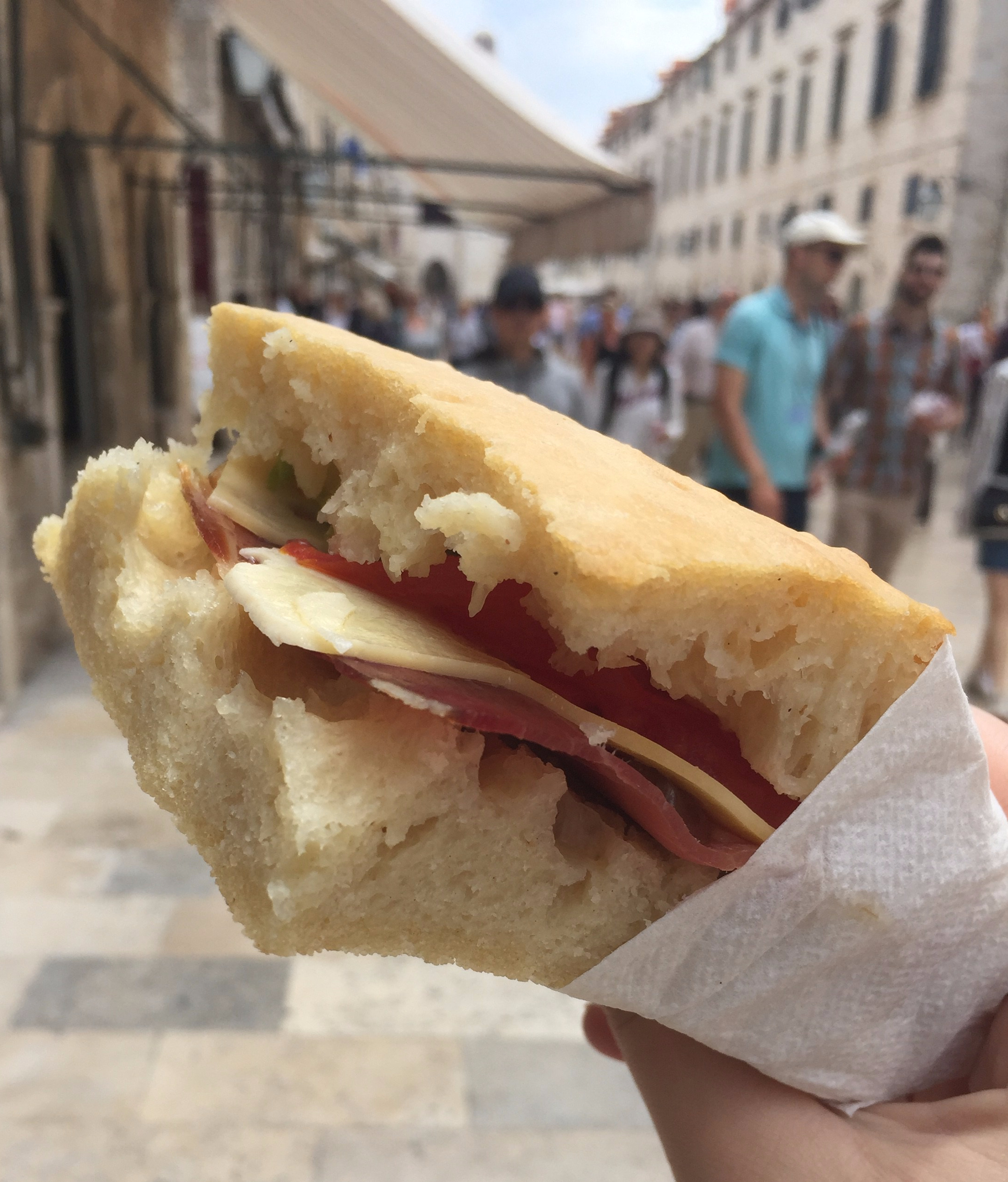
Ham and Cheese Sandwich from Buffet Skola
12pm: The Great Wall of Croatia
The Old Town of Dubrovnik is encircled by 2km of walls and walking their perimeter is a highlight of any visit. The walls were built during the 14th and 15th centuries to protect the city from invaders and have been extremely well preserved. There are a few entrances to the walls, but the main one is at the beginning of Stradun. The entrance price has increased over the past few years and was 150 kuna (~$25) in 2017, but I’d definitely still deem it worthwhile. The walk takes an hour or 2 depending on your pace, and there are towers to climb and multiple cafes to visit for a coffee or ice cream along the way. In May, the crowds were bearable on the walls at noon, but if you’re traveling during peak season, you may consider beginning your morning with a walk around the walls followed by a walking tour at noon to beat the influx of crowds from the cruise ships!
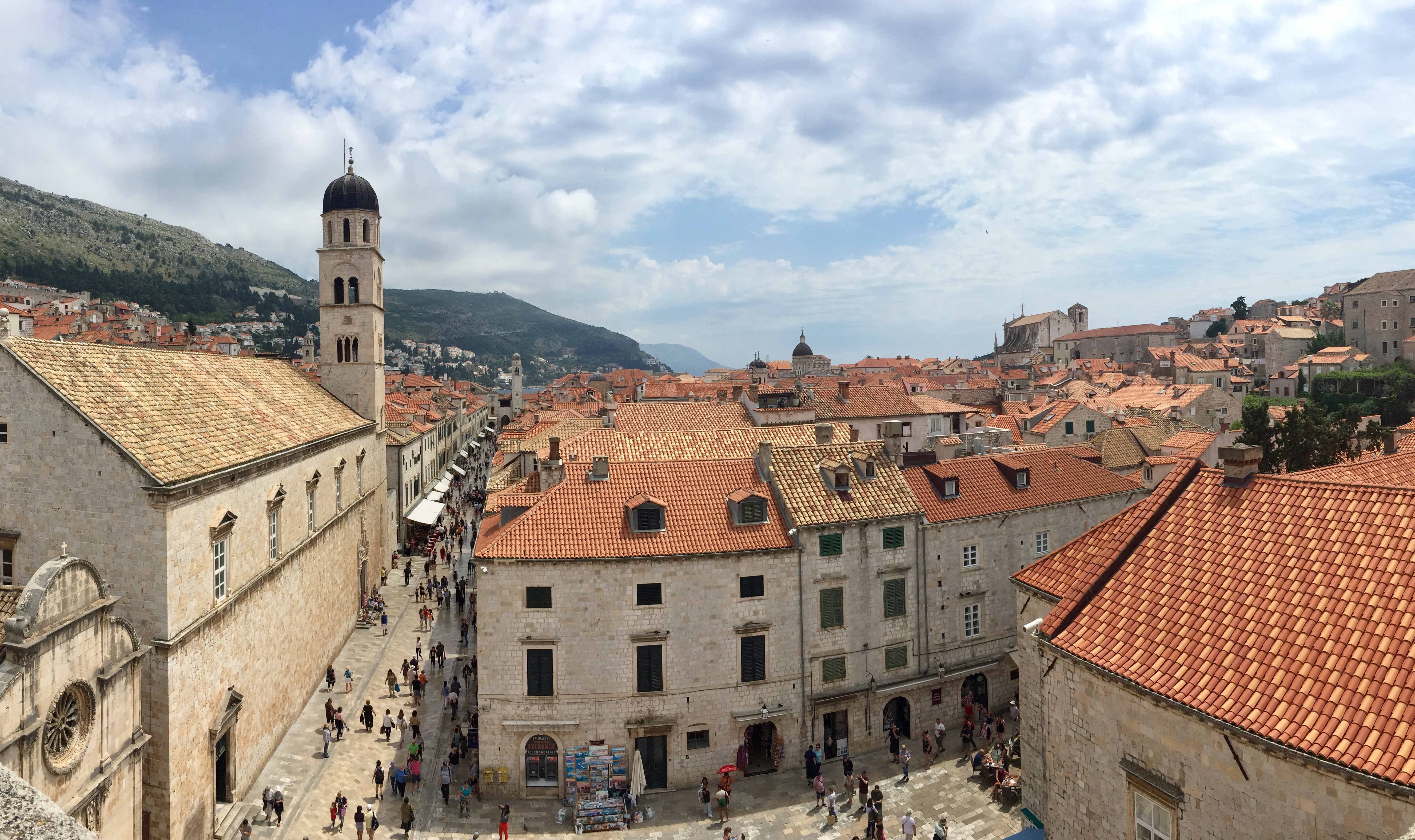
View of Stradun from the Walls
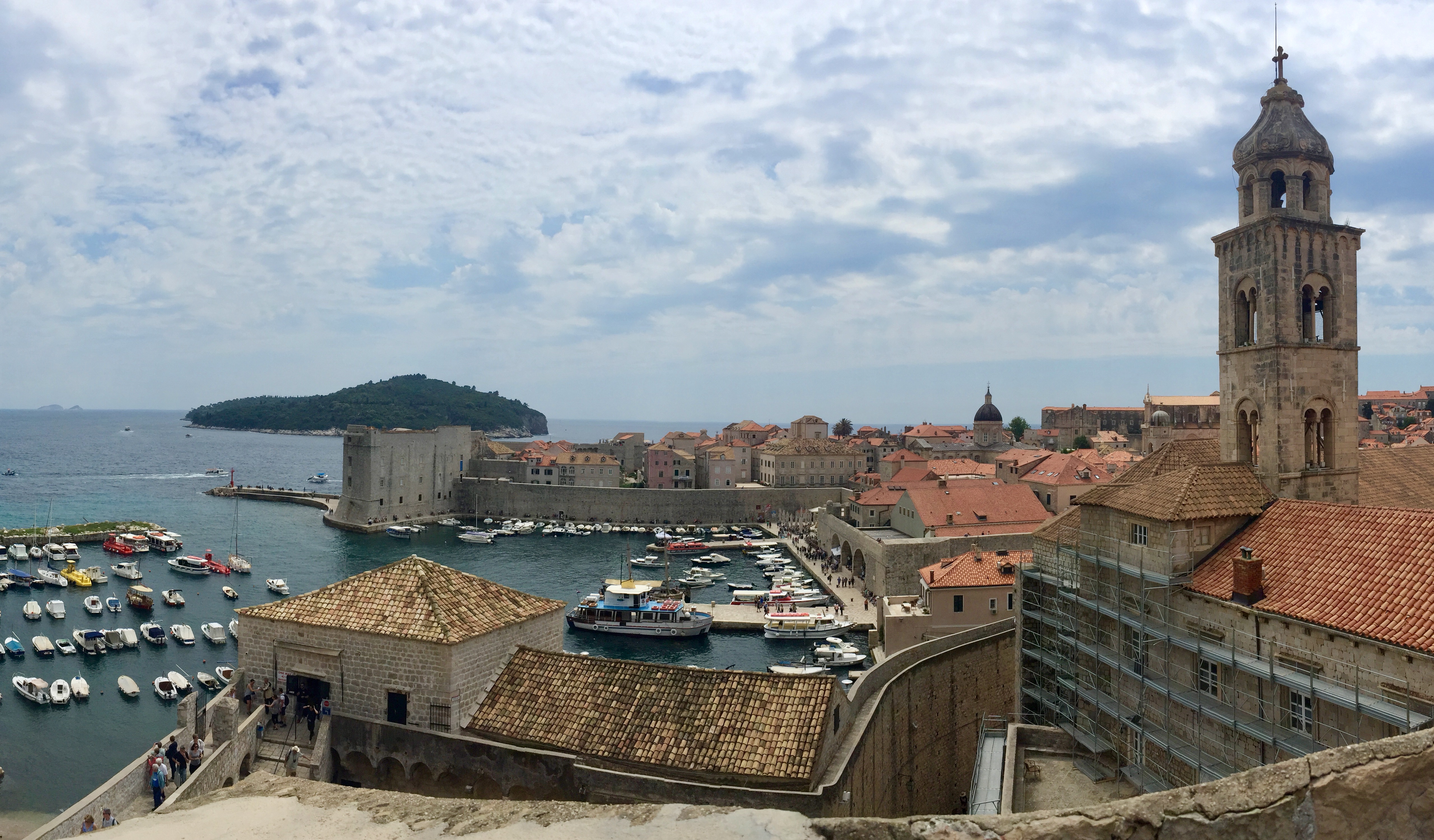
View of the Old Port from the Walls
After walking the perimeter of the Old Town, exit the city from the Pile gate and head to Lovrijenac — the fortress you probably noticed as being detached from the rest of the wall! For another great view of the city, climb to the top of Lovrijenac — the price of admission is included with the purchase of a ticket to the Walls. The picture of the walls at the top of this post was taken from Lovrijenac!
If you didn’t make it to Dodo Bar yesterday, stop by on the way to or from Lovrijenac — who wouldn’t enjoy a coffee or cocktail on a swing overlooking the Adriatic?
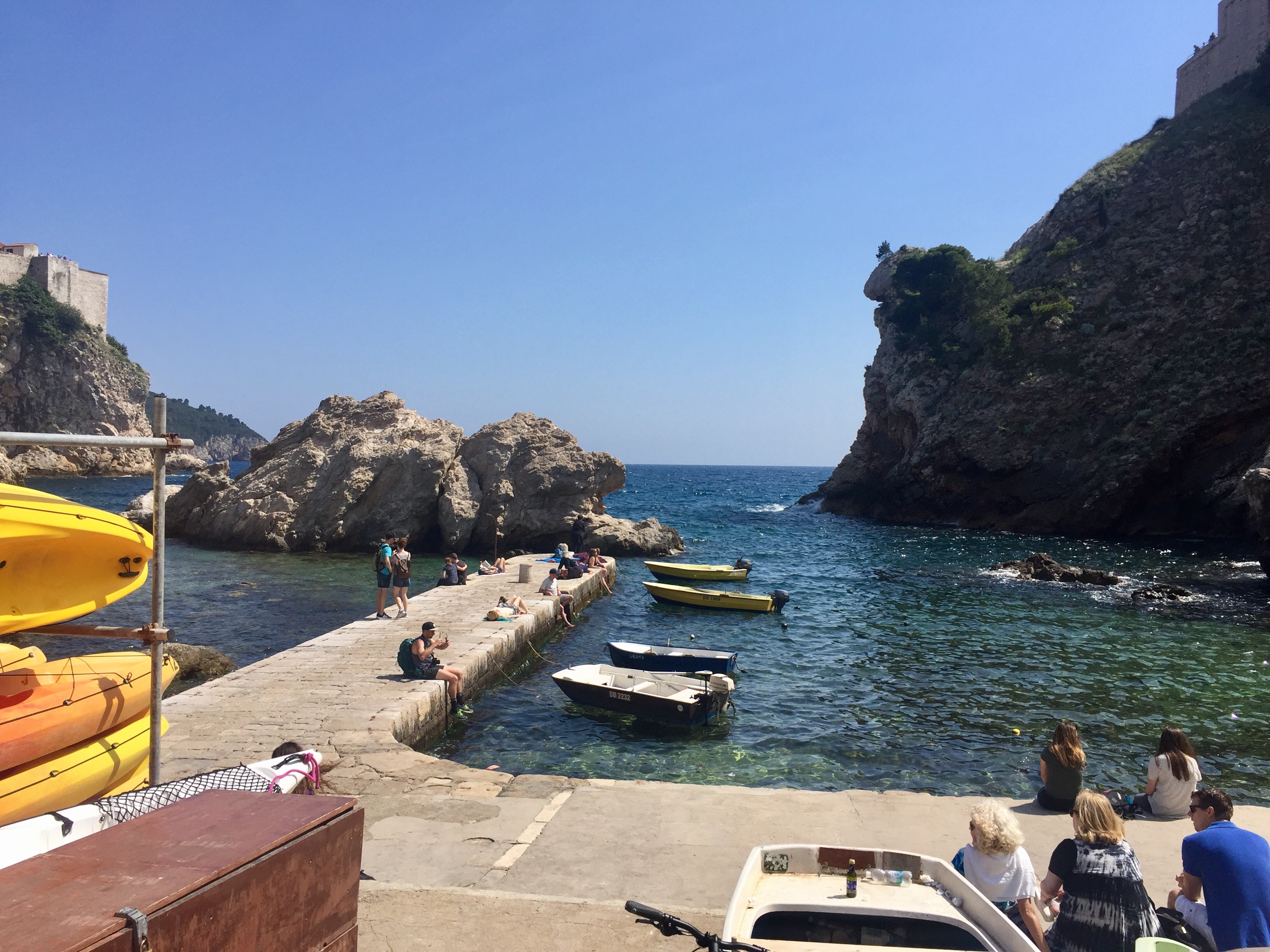
Cove under Lovrijenac
3pm : Hiking the Hill
Next up, the ascent to the top of Srd Hill for more great views of this beautiful city! The Imperial Fortress perched atop Srd Hill has had strategic importance for Dubrovnik since the 19th century and, most recently, during the Siege of Dubrovnik. On a clear day, you can see 37 miles around the city from the hill! The views are incredible and I’d definitely suggest the trip. Most people take the cable car to the top of the hill, but you can also walk up a path. Our Airbnb happened to be close to the trail head so we decided to do the hike! If you catch the cable car from the Old Town, it is located a minute from the Buza Gate – quickest way to get there is to take the stairs from Stradun. If you exit from Ploce or Pile gates, there is also a sidewalk around the city walls which leads to the station. The roundtrip price of the cable car ticket is 140kn or ~$22 and tickets can be bought there.
If you are up for the hike, it takes about 45 minutes from the Old Town! The path zig-zags up the side of the hill, so it is not especially steep, but it is a bit rocky so I’d definitely recommend wearing sneakers. To reach the path, you will make your way towards the entrance on Jadranska Cesta (Dubrovnik’s two-way highway). The trail head is even searchable on Google Maps! Make sure you bring plenty of water and sunscreen if you do choose to hike the hill as the majority of the path is open and you’ll be exposed to the strong Croatian sun.
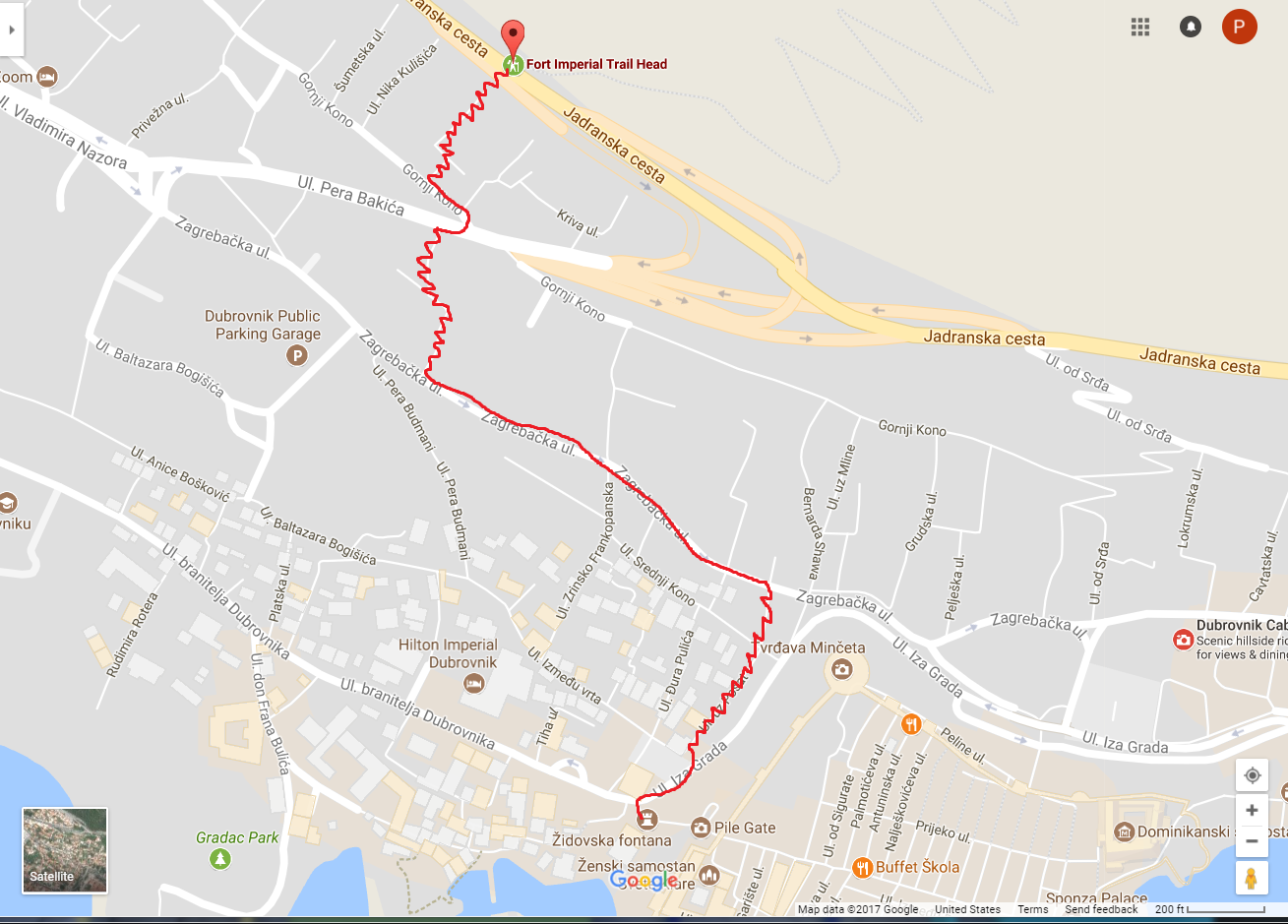
Walking route from Pile Gate to the trail head
Once you cross the highway and start the actual ascent, you’ll be treated with great views almost immediately. The hike up would’ve been much faster if we hadn’t been tempted to stop for a picture every 5 minutes! The views along the hike rival those you’ll find at the top. When you reach the summit, you’ll be right by the Homeland War Museum. If you’re interested in learning more about the Siege of Dubrovnik, the museum is packed with reading materials, artifacts, and video from wartime. There is a 30kn (~$5) admission charge, but definitely worth it if you are fascinated by the Homeland War.
In addition to the Museum, you can go to the Panorama restaurant for a drink or snack at the summit of Mount Srd. We didn’t try the restaurant, but I’d imagine it’s hard not to love a restaurant overlooking the ocean, Dubrovnik, and its 37-mile radius!
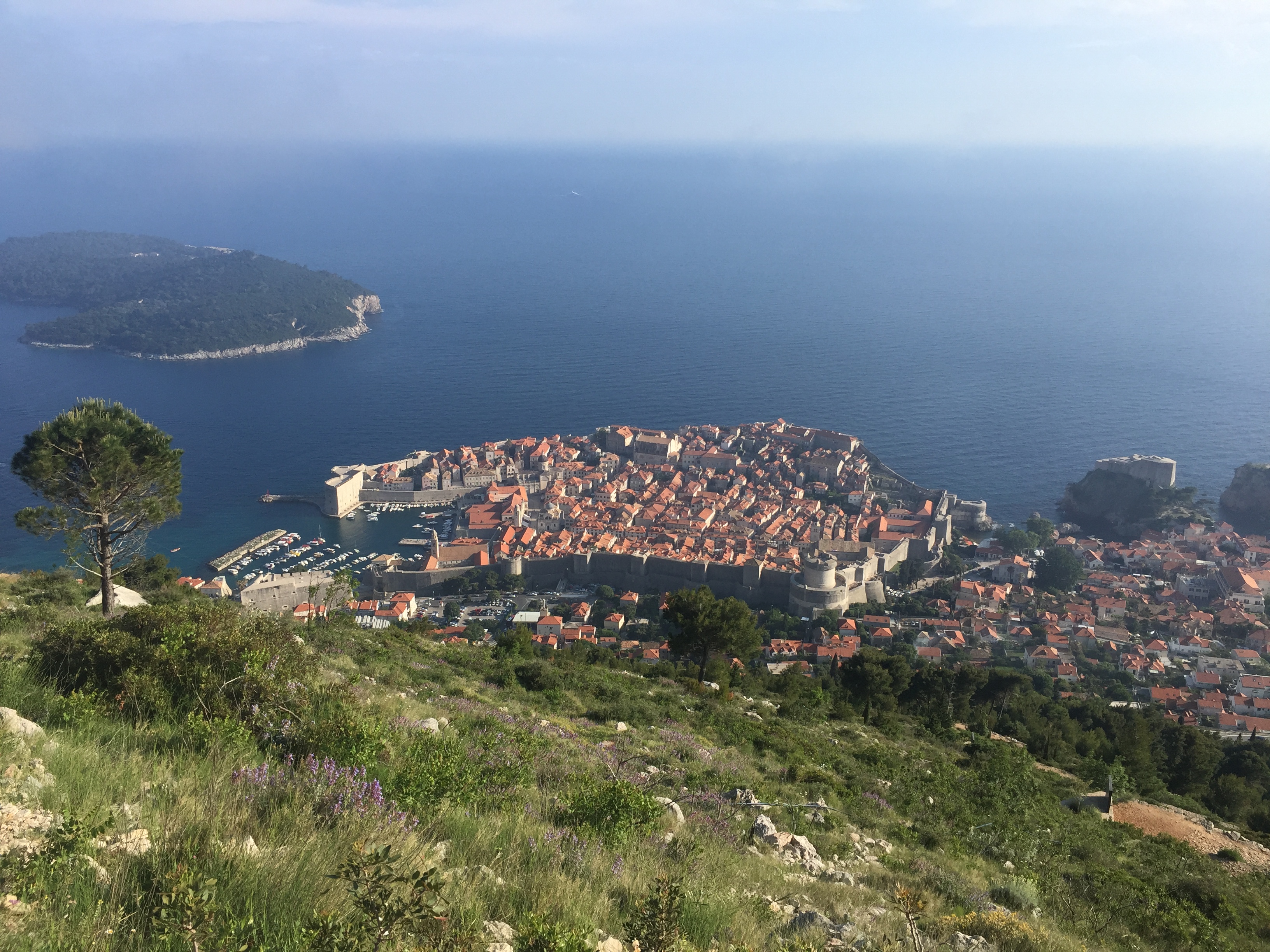
Old Town from the top of Srd Hill
6:30 pm : Trying our First Plavac Mali
After trekking back down the hill and getting ready for the evening, we headed to D’vino Wine Bar! We were extremely excited to try lots of wine on our trip through Croatia and D’Vino was a great place to start. The bar focuses on small wine producers and family vineyards from Croatia and has a number of different tastings which you can order at any time! We tried both the white and the red tasting flights which start at 55kn (~$9). We even had one of our favorite wines throughout our trip here — Matusko Vineyards Plavac Mali Postup. On top of having great wine, D’vino is a cozy spot with attentive staff who are happy to share as much (or as little) as you want to know about the wines you’re enjoying.
8pm : Dinner (Hopefully not in the rain)
We ate our second meal in Dubrovnik at Azur, a Croatian-fusion restaurant. The restaurant is located on a cute street in the Old Town and we enjoyed our meal at a table on the street. I was both intrigued and skeptical by the fusion menu, but the food was delicious and reasonably priced for Dubrovnik! We had the Curry Coconut Meatballs and the Seared Tuna and would recommend both. The food at Azur was different from anything else we ate in Croatia and it’s definitely worth a visit. Our dinner was slightly interrupted by a torrential downpour, but we grabbed our plates and took shelter under one of the few tables with an umbrella. We were the only people who stayed outside during the brief storm and the waitress found it so hilarious that she insisted on taking our photograph — but we were happy to be eating our food!

Delicious seared tuna!

Dinner in the rain!
If you’re up for a big night out in Dubrovnik, head to Revelin. It’s the city’s most infamous club and the venue is a 500-year old fortress — reason enough for us to want to check it out! The locals we met were all very proud of all the famous DJs and musical acts who have come to their small city to play at Revelin. We had numerous tour guides suggest we check it out, but in the high season, be sure to check their website for info on possible cover charges, etc.
Day Three
9 AM : Inhabiting the Uninhabited Island
We started our day early (for us!) on a kayak tour with Adventure Dalmatia. The tour was about 3 hours — half of which was spent paddling! We started from the cove by Lovrjenac Fort and we paddled past the city walls and out to Lokrum Island. Lokrum is the island you’ve undoubtedly seen right off the coast of Dubrovnik. It’s an uninhabited island and only allows visitors to come for the day. We circled Lokrum island and explored a cool cave on the Eastern edge of the island. We continued paddling back towards the shore to Betina Cave, a small hidden beach! We stopped to swim and have a quick snack in the idyllic cave, while also relaxing our arms for a bit! We paddled back, catching a glimpse of the Old Port from the water, and getting up close to the walls. It was cool to see the city from the other side of the walls and we had a great time chatting with our guide as we paddled around the island! We booked our tour in advance by emailing the company, but you can also head down to the square by Pile Gate and sign up for a kayak tour (and many others!) when you arrive in Dubrovnik.
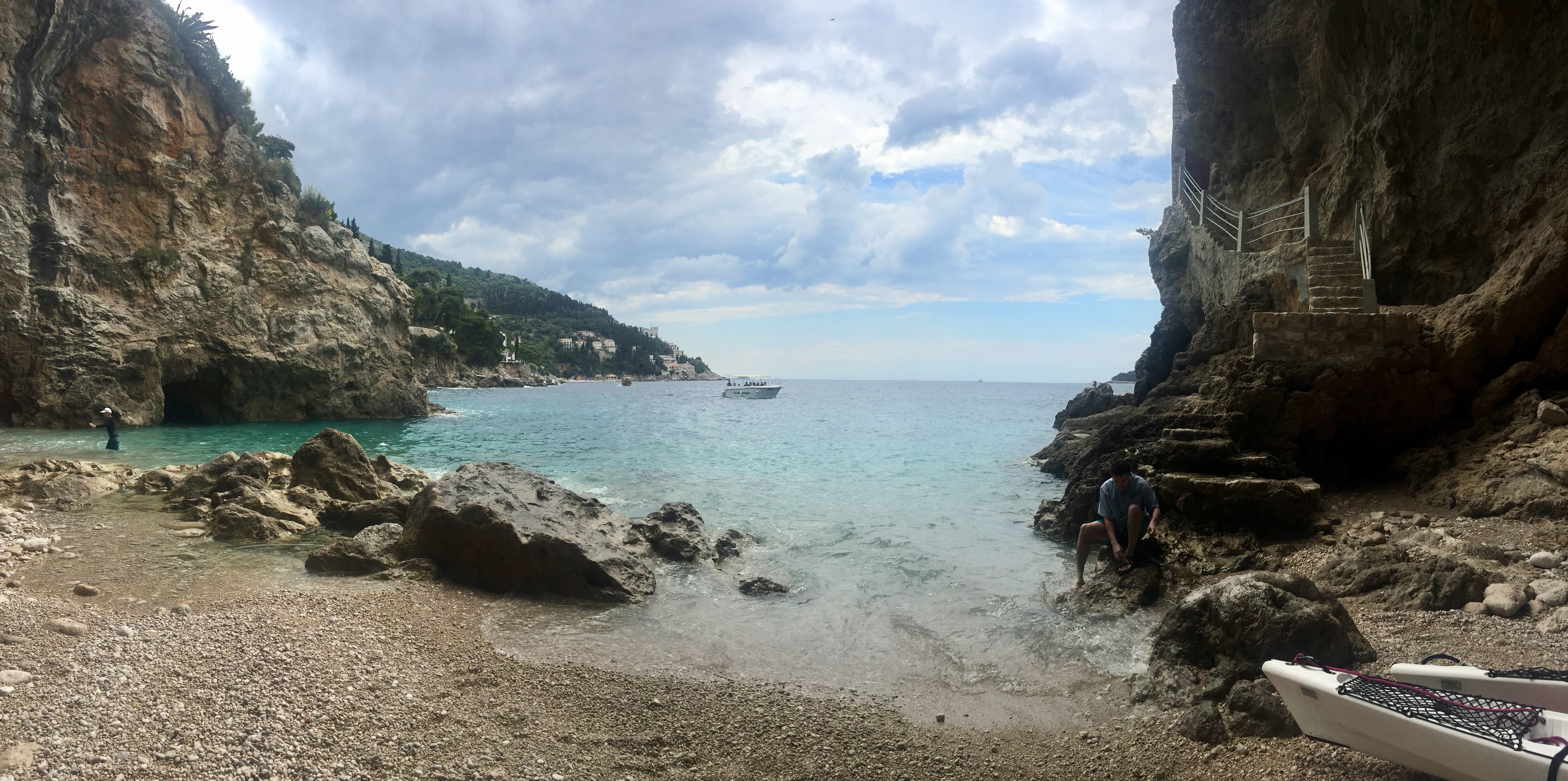
View from Betina Cave
If you’d rather not spend the morning breaking a sweat on the water (or you did in fact go to Revelin last night), you can also visit Lokrum island by ferry this morning! It’s extremely easy to get to Lokrum by ferry, departing from the Old Port starting at 9AM and running every half hour until 6. Just make sure you don’t miss the last ferry back at 7pm — rumor is that you’ll be escorted off the island by police if you’re found there afterwards. The ferry only takes 10 minutes and costs 96kn (~$15).
Once on Lokrum, you can elect to swim, explore the 1.5 mile long island by foot, or visit Lacroma Restaurant! If you’re looking for a swim, there are beaches on the island, as well as Croatia’s very own “Dead Sea” — a salt-filled lake which is popular due to how easy it is to swim in! If you elect to walk around the island, there is a Benedictine monastery which you can explore, 800+ plant species to see, and peacocks to keep your eye out for! It’s easy to spend a few hours (or an entire day) exploring or relaxing on Lokrum Island!
1 PM : Bosnia and Herzegovina Bound
After the kayak tour, we set out for Sarajevo! It was the second stop on our 10-day trip through Croatia and Bosnia and Herzegovina and we were excited to make our way there in our little stick-shift Fiat!














Theresa Richards
Delightful!! Want to book our trip today. History water, good food; what’s not to like
!
april auxtero
I enjoyed reading this. Just a perfect appetizer for our trip to this walled city next week. Thanks!
Jill
very informative – thanks
ray
great review- particularly liked the potted history of the conflict past. We are here in Dubrovnik just now and had been in several of the places you mentioned. We have only been here two nights but have also enjoyed the food at Amoret (old town complete with guitarist) and a Mexican called Bona Fide.
Going to Lokrum tomorrow.
Tip for UK travellers- its London prices here! Standard bottle of beer anywhere here is 35 kuna (£4.30).
tina
wow ,great review ,glad I clicked on the link !
cant wait for my weekend visit in march ,with plenty of ideas what to do !
suemclaurinmakeup
Thanks for a very informative blog… We are headed to Dubrovnik in March, very excited.
tina rhynehart
Do you continue your Dubrovnik blog with info on Sarajevo?
tina rhynehart
I really enjoyed the info on Dubrovnik and would like additional info on Sarajevo!
Paige Richards
Sarajevo blog is in the works! I’d be happy to send you a message with some recommendations in the meantime!
Yolanda Reza
Thank you! A great informative blog! Excited to start planning my trip!
Laura Dalton
My daughter and I will be traveling to Dubrovnik in May. So excited! Would you recommend a day trip to Bosnia or Montenegro?
Paige Richards
Hi Laura! We only made it to Bosnia, so I cannot speak to Montenegro unfortunately. Mostar is more than a 3-hour trip from Dubrovnik each way, so not a short trip for the day. I think it makes alot of sense if you’re travelling from Dubrovnik to Split, but I’d be more hesitant to recommend if you’re going to/from Dubrovnik. It’s a stark contrast from Croatia, so definitely an interesting add-on to a Croatian trip though. The Muslim influence in the city is very prominent, so it’s an interesting cultural experience. We spent our time there walking around (and eating), but aside from the central bridge (Stari Most), I wouldn’t say there are alot of “must sees”. Kotor is definitely closer than Mostar, so if you’re definitely doing a trip to/from Dubrovnik for one day, it might be a more enjoyable day. It looks absolutely gorgeous from the pictures!
Bianca Larson
Hi Paige! I really enjoyed your blog on Dubrovnik. Thank you so much for sharing your experiences. Is your Mostar blog up yet? We are going to Croatia this September and thinking of adding Mostar. It seems you didn’t find it as interesting. Any recommendations you would like to share, if your blog is not up?
Paige Richards
Hi Bianca! I’m glad you enjoyed the read. We stopped in Mostar on our way to Sarajevo and since the drive took longer than expected, we only ended up being there for a few hours to have lunch and walk around. I wasn’t able to give the city enough time to judge it accurately. As a whole, Bosnia is an extremely interesting country and you would be able to get a feel of this in Mostar. I’d say my only hesitation on recommending it is that it’s a bit of a trek from the cities in Croatia where most people are coming from. We did the drive from Dubrovnik and it was 3-4 hours, involving a wait for the border crossing and hours on small, one lane roads. We definitely learned the hard way that we should’ve spent more time planning the route we took in the car and not to just take the first route suggested by an iPhone. Overall, if you’re making the trip from Dubrovnik or Split, I think you might have a more enjoyable day if you pick a day trip that won’t involve as many hours on the road. Then again, if you’re not going to make it to Bosnia otherwise, you might want to include it in your itinerary. I’d say if you’re interested in history and/or religion, spend a day in Mostar and find a great tour and you’ll learn a lot and be fascinated. If this isn’t your cup of tea, make a day trip elsewhere! Sorry that was a long answer, but it definitely depends on your interests.
Anna Logue
We’re going to Dubrovnik in June and this was a fab introduction to what we should try to see! Thank you!
In terms of your walking tour of the Old Town, did you book this in advance or when you got there?